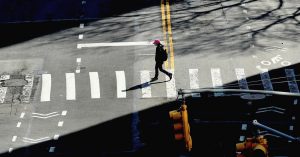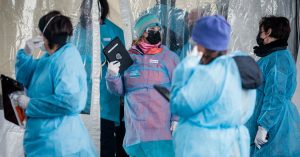Three months into a global pandemic that is straining the fabric of America’s society, political leaders say that the nation is facing a stark choice between economic prosperity and the preservation of human life. Andrew Cuomo, the governor of New York, has given voice to the sentiments of many by insisting that every life is priceless and that the government must be prepared to sacrifice prosperity to prevent deaths. “We will not put a dollar figure on human life,” he declared.
Dan Patrick, the lieutenant governor of Texas, took the opposite view last week, arguing that Americans should go back to work even if that causes the deaths of their grandparents, whom he suggested would willingly sacrifice their lives for the sake of economic growth. President Trump grudgingly agreed Sunday night to extend the federal government’s social distancing guidelines until the end of April, but he too has made clear that he believes efforts to save lives will come at the expense of the economy.
This is a false choice. While policymakers must sometimes make trade-offs between life and money, this is not such a moment. The American economy needs to be shut down in order to preserve both human life and long-term prosperity. During the 1918 influenza pandemic, communities that quickly imposed stringent measures not only saved lives but experienced stronger economic rebounds, according to a new study. The message is clear: Coronavirus is a danger to life and prosperity; a strong public health response is the needed corrective.
It increasingly appears necessary that for the next eight weeks, and possibly for longer, all nonessential businesses should be closed, domestic travel restricted and the “shelter-in-place” measures being employed by some parts of the country extended to the rest. Such a shutdown will be enormously expensive in the short term, likely requiring fresh rounds of federal aid on top of the $2.2 trillion Congress approved on Friday. But scientists say that based on what they’ve learned from Europe and Asia, that’s the only way to get the virus, which is spreading like wildfire across the country, under control.
Those extreme measures still will not end the epidemic completely. But the United States cannot long endure in a state of suspended animation, nor can the nation easily bear the cost of repeated lockdowns. That’s why it is also critical to fund and implement the safety measures necessary to let Americans get back to work, school and play without a recrudescence of the virus.
In fact, a nationwide lockdown should be seen as only the first step in a long fight that will proceed at a different pace in different parts of the country. In New York, where doctors and nurses dressed in trash bags and bandannas are desperately fighting to contain the virus even as bodies pile up, the crisis is upon us. In three weeks, when case counts in New York may be peaking, outbreaks in other parts of the country might just be entering a phase of deadly exponential growth. The virus may complicate matters even further by receding in late spring or summer, only to re-emerge in the fall or winter.
We need to prepare for what’s ahead.
Test, Test, Test
The virus will almost certainly re-emerge as individual states and cities start to lift the strictures of social distancing and shelter-in-place — but, ideally, that re-emergence will look more like a string of smaller brush fires than one raging forest fire. Health officials will not be able to detect those brush fires, or keep them from growing, without diagnostic tests. They will need enough tests both to survey the population at random and to diagnose patients who experience symptoms. They will also need the capacity to isolate those who test positive, and to identify, quarantine and monitor their contacts. If those contacts develop symptoms, they’ll need to be able to test them, too.
To build such capacity, the federal government will have to invest in the nation’s undervalued and deeply strained public health system: more funding will be crucial, but it will not be enough. State and federal leaders should work together, now, to create a public works corps to assist epidemiologists with contact tracing, to erect thousands of drive-through testing sites, and to do the work of infection control in nursing homes and homeless shelters. Some states are already doing this on their own, but others will need federal funding — perhaps in the form of block grants.
Antibody tests, which can determine whether someone has been exposed to the virus and may therefore be immune, will help get people back to work safely, allowing individuals and public health authorities to gauge who can proceed without worry, and who needs to take additional precautions. Scientists, in America and elsewhere, have already developed such tests. The federal government should orchestrate production of the tests in the necessary numbers.
Public health authorities also should oversee the creation of temperature checkpoints outside of factories and office buildings, and in other close-packed or high-traffic places — and those measures should be increased anytime disease detectives find the hint of a brewing outbreak. This will take a combination of state-level mandates and aggressive public advertising campaigns. People hate being told what to do, never more so than when it comes to their own bodies; clear and consistent messages will help mitigate the predictable pushback.
Get Producing
The Trump administration’s initial reluctance to treat the coronavirus as a serious threat, and its deference to corporations, has left the United States badly behind in producing needed supplies and equipment like ventilators, intensive care unit beds, masks, swabs, gowns and gloves.
After weeks of costly hesitation, President Trump invoked the Defense Production Act on Friday to require General Motors to produce ventilators. It is a welcome step, but more is required. The administration must act to expand production of other needed supplies, too, both to deal with outbreaks happening now and to prepare for hot spots that are sure to emerge. Some companies are producing these supplies, but those efforts remain inadequate and uncoordinated. Only the White House can provide the necessary leadership.
Hospitals around the country will also need surge capacity — the physical space to isolate and treat contagious patients and to make use of additional beds and ventilators — for many months to come. States like New York and Washington have been forced to build this capacity mid-crisis, by calling on the National Guard and pleading with the federal government for support. Other states should be planning now for the same life-or-death struggle.
Track and Share Data
As new outbreaks pop up, experts will need data to guide their decision making. Information — on hospital capacity and viral spread, among other things — that is centrally located, regularly updated and readily available will be essential to figuring out when or whether social distancing or other measures need to be implemented again.
So far, no such system exists. As a result, most local governments don’t have efficient ways to track supplies of personal protective equipment or monitor and publicly report their hospital and I.C.U. capacity. What should the chronically ill in a given region do during an outbreak? Where should those with asthma go if they have an attack? The fact that most Americans don’t know the answers to those questions is dangerous and inexcusable in an era of such data abundance.
Some scientists are working to rectify that problem — to create the apps and websites that such a crisis demands. But those efforts will only be useful if they are brought to scale quickly. That, too, will take federal oversight and financial support.
There is no shortage of analogies for how to think about these components of the long-term response: It’s a Marshall Plan, an Apollo mission and a New Deal all rolled into one. However this is framed, it needs to happen fast for the sake of both the economy and the public’s health. “The half measures we’re taking now are doing real harm to people’s livelihoods without doing as much as they could to slow the virus,” says Jeremy Konyndyk, a senior policy fellow at the Center for Global Development.
It will be difficult to explain these past few weeks to future generations — how terror and complacency sat so close together, how despite years of warnings from global experts and weeks of signaling from Asia and Europe, America’s leaders failed to prepare for the inevitable, and how even as sickness and death surpassed the capacity of hospitals and funeral homes, they did not act decisively.
There is still a chance to avoid the worst outcomes, but time is short.
The Times is committed to publishing a diversity of letters to the editor. We’d like to hear what you think about this or any of our articles. Here are some tips. And here’s our email: [email protected].
Follow The New York Times Opinion section on Facebook, Twitter (@NYTopinion) and Instagram.



















